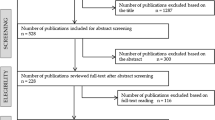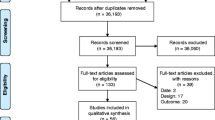Abstract
Introduction: This systematic review evaluated the quality of psychometric properties of self-report health-related work outcome measures for patients with musculoskeletal disorders. Methods: Electronic searches of MEDLINE, EMBASE, and Cumulative Index to Nursing and Allied Health Literature (CINAHL) between 1980 and December 2006 were conducted for peer-reviewed studies that evaluated self-report work outcome measures for patients with musculoskeletal disorders. The eligibility criteria for the papers included in the review were articles that: (1) discussed the psychometric evaluation of a self-reported health-related work outcome measure, (2) were conducted with patients who were diagnosed with musculoskeletal disorders, (3) were written as peer-reviewed full published reports, and (4) were published in English. Three pairs of reviewers used a modified rating form and evaluated the quality of the psychometric properties of the instruments described in the retrieved articles. Results: Of the 740 articles that were identified, six instruments in eight studies met the inclusion criteria. None of the instruments demonstrated satisfactory results for all properties. Overall, the highest quality ratings were given to the Functional Abilities Confidence Scale and the Occupational Role Questionnaire. Conclusions: Although validation studies of self-report health-related work outcome measures for patients with musculoskeletal disorders exist, they appear to be limited in the quality of their psychometric properties. There is a need to continue to validate health-related work outcome measures and to make them more meaningful for patients and clinicians.
Similar content being viewed by others
References
Butler, R. J., Johnson, W. G., & Baldwin, M. L. (1995). Managing work disability: Why first return to work is not a measure of success. Industrial & Labor Relations Review, 48, 453–469.
Workplace Safety and Insurance Board. Annual Report 2005. Available at: http://www.wsib.on.ca Accessed February 12, 2007.
Brouwer, W. B. F., Koopmanschap, M. A., & Rutten, F. F. H. (1999). Productivity losses without absence: Measurement validation and empirical evidence. Health Policy, 48, 13–27.
Stewart, W. F., Ricci, J. A., & Leotta, C. (2004). Health-related lost productive time (LPT): Recall interval and bias in LPT estimates. Journal of Occupational and Environmental Medicine, 46(6 suppl), S12–S22.
Boden, L. I., Biddle, E. A., & Spieler, E. A. (2001). Social and economic impacts of workplace illness and injury: Current and future directions for research. American Journal of Industrial Medicine, 40, 398–402.
Burton, W. N., Pransky, G., Conti, D. J., Chen, C.-Y., & Edingon, D. W. (2004). The association of medical conditions and presenteeism. Journal of Occupational and Environmental Medicine, 46(6), S38–S45.
Kessler, R. C., Greenberg, P. E., Mickelson, K. D., Meneades, L. M., & Wang, P. S. (2001). The effects of chronic medical conditions on work loss and work cutbacks. Journal of Occupational and Environmental Medicine, 43(3), 218–225.
Lerner, D. J., Amick, B. C., Malspeis, S., & Rogers, W. H. (2000). A national survey of health-related work limitations among employed persons in the United States. Disability and Rehabilitation, 22, 225–232.
Loeppke, R., Hymel, P. A., Loftland, J. H., Pizzi, L., Konicki, D. L., Anstadt, G. W., et al. (2003). Health-related workplace productivity measurement: General and migraine-specific recommendations from the ACOEM expert panel. Journal of Occupational and Environmental Medicine, 45, 349–359.
Ilmarinen, J., & Rantanen, J. (1999). Promotion of work ability during ageing. American Journal of Industrial Medicine, 38(Suppl 1), 21–23.
De Zwart, B. C. H., Frings-Dresen, M. H. W., & van Duivenbooden, J. C. (2002). Test–retest of the Work Ability Index questionnaire. Occupational Medicine, 52(4), 177–181.
Amick, B. C., Lerner, D., Rogers, W. H., Rooney, T., & Katz, J. N. (2000). A review of health-related work outcome measures and their uses, and recommended measures. Spine, 25(24), 3152–3160.
Lotters, F., Meerding, W. J., & Burdorf, A. (2005). Reduced productivity after sickness absence due to musculoskeletal disorders and its relation to health outcomes. Scandinavian Journal of Work Environment & Health, 31(5), 367–374.
Koopman, C., Pelletier, K. R., Murray, J. F., Sharda, C. E., Berger, M. L., Turpin, R. S., et al. (2002). Stanford Presenteeism Scale: Health status and employee productivity. Journal of Occupational and Environmental Medicine, 44, 14–20.
Turpin, R. S., Ozminkowski, R. J., Sharda, C. E., Collins, J. J., Berger, M. L., Billot, G. M., et al. (2004). Reliability and validity of the Stanford Presenteeism Scale. Journal of Occupational and Environmental Medicine, 46(11), 1123–1133.
Feuerstein, M., Nicholas, R. A., Huang, G. D., Haufler, A. J., & Pransky, G. (2005). Workstyle: Development of a measure of response to work in those with upper extremity pain. Journal of Occupational Rehabilitation, 15(2), 87–104.
Feuerstein, M., & Nicholas, R. A. (2006). Development of a short form of the workstyle measure. Occupational Medicine, 56, 94–99.
Prasad, M., Wahlqvist, P., Shikiar, R., & Shih, Y. (2004). A review of self-report instruments measuring health-related work productivity. A patient-reported outcomes perspective. Pharmacoeconomics, 22, 165–184.
Lofland, J. H., Pizzi, L., & Frick, K. D. (2004). A review of health-related workplace productivity loss instruments. Pharmacoeconomics, 22(3), 165–184.
Evans, C. J. (2004). Health and work productivity assessment: State of the art or state of flux? Journal of Environmental Medicine, 46(6 Supplement), 3–11.
Lohr, K. N., Aaronson, N. K., Alonso, J., Burnam, M. A., Patrick, D. L., Perrin, E. B., et al. (1996). Evaluating quality-of-life and health status instruments: Development of scientific review criteria. Clinical Therapeutics, 18(5), 979–992.
Guyatt, G. H., Feeny, D. H., & Patrick, D. L. (1993). Measuring health-related quality of life. Annals of Internal Medicine, 118, 622–629.
Kirshner, B., & Guyatt, G. H. (1985). A methodological framework for assessing health indices. Journal of Chronic Diseases, 38, 27–36.
Streiner, D. L., & Norman, G. R. (1995). Health status measures. A practical guide to their development and use. New York: Oxford Medical Publications.
DeVellis, R. F. (1991). Scale development theory and application. Newbury Park, CA: Sage Publications.
Nunnally, J. C. (1978). Psychometric theory (2nd ed.). New York: McGraw Hill.
Bland, J. M., & Altman, D. G. (1996). Measurement error and correlation coefficients. BMJ, 313, 41–42.
Terwee, C. B., Dekker, F. W., Wiersinga, W. M., Prummel, M. F., & Bossy, P. M. M. (2003). On assessing responsiveness of health-related quality of life instruments. Quality of Life Research, 12, 349–362.
Liang, M. H. (2000). Longitudinal construct validity. Establishment of clinical meaning in patient evaluative instruments. Medical Care, 38(9 suppl), II84–II90.
Bot, S. D. M., Terwee, C. B., van der Windt, D. A. W. M., Bouter, L. M., & de Vet, H. C.W. (2004). Clinimetric evaluation of shoulder disability questionnaires: A systematic review of the literature. Annals of the Rheumatic Diseases, 63, 335–341.
Williams, R. M., & Myers, A. M. (1998). Functional Abilities Confidence Scale: A clinical measure for injured workers with acute low back pain. Physical Therapy, 78, 624–634.
Kopec, J. A., & Esdaile, J. M. (1998). Occupational role performance in persons with back pain. Disability & Rehabilitation, 20(10), 373–379.
Durand, M.-J., Vachon, B., Hong, Q. N., Imbeau, D., Amick, B. C., & Loisel, P. (2004). The cross-cultural adaptation of the Work Role Functioning Questionnaire in Canadian French. International Journal of Rehabilitation Research, 27(4), 261–268.
Lerner, D., Amick, B. C., Rogers, W. H., Malspeis, S., Bungay, K., & Cynn, D. (2001). The Work Limitations Questionnaire. Medical Care, 39(1), 72–85.
Lerner, D., Reed, J. I., Massarotti, E., Wester, L. M., & Burke, T. A. (2002). The work limitation’s validity and reliability among patients with osteoarthritis. Journal of Clinical Epidemiology, 55(2), 197–208.
Walker, N., Michaud, K., & Wolfe, F. (2005). Work limitations among persons with rheumatoid arthritis: results, reliability and validity of the Work Limitations Questionnaire in 836 patients. Journal of Rheumatology, 32(6), 1006–1012.
Beaton, D. E., & Kennedy, C. A. (2005). The Workplace upper extremity research group. Beyond return to work: testing a measure of at-work disability in workers with musculoskeletal pain. Quality of Life Research, 14, 1869–1879.
Gilworth, F., Chamberlain, M. A., Harvey, A., Woodhouse, A., Smith, J., Smyth, M. G., et al. (2003). Development of a Work Instability Scale for rheumatoid arthritis. Arthritis and Rheumatism, 49(3), 349–354.
Williams, R. M., & Myers, A. M. (1998). A new approach to measuring recovery in injured workers with acute low back pain: Resumption of activities of daily living scale. Physical Therapy, 78, 613–623.
Ryckman, R. M., Robbins, M. A., Thornton, B., Cantrell, P. (1982). Development and validation of a Physical Self-Efficacy Scale. Journal of Personality and Social Psychology, 42, 891–900.
Roland, M., & Morris, R. (1983). A study of the natural history of back pain. Part 1: The development of a reliable and sensitive measure of disability in low back pain. Spine, 8, 141–145.
McHorney, C. A., Ware, J. E., & Raczek, A. E. (1993). The MOS 36-item Short-Form Health Survey (SF-36). II. Psychometric and clinical tests of validity in measuring physical and mental health constructs. Medical Care, 31, 247–263.
Bellamy, N., Kirwan, J., Boers, M., Brooks, P., Strand, V., Tugwell, P., et al. (1997). Recommendations for a core set of outcome measures for future phase III clinical trials in knee, hip, and hand osteoarthritis. Consensus development at OMERACT III. Journal of Rheumatology, 24, 799–802.
Beaton, D. E., Katz, J. N., Fossel, A. H., Tarasuk, V., Wright, J. G., & Bombardier, C. (2001). Measuring the whole or the parts. Validity, reliability and responsiveness of the DASH outcome measure in different regions of the upper extremity. Journal of Hand Therapy, 14, 128–146.
Cohen, J. (1988). Statistical power analysis for the behavioral sciences. Hillsdale, NJ: Lawrence Erlbaum Associates Publishing Co.
Kazis, L., Anderson, J. J., & Meenan, R. F. (1989). Effect sizes for interpreting changes in health status. Medical Care, 27(Supplement), 178–189.
Wright, J. G., & Young, N. L. (1998). Comparison of different indices of responsiveness. Journal of Clinical Epidemiology, 50, 239–246.
Guyatt, G. H., & Rennie, D. (Eds.) (2002). Users’ guide to the medical literature. Essentials of evidence-based practice. Chicago, IL: AMA Press.
Acknowledgements
A special thank you goes to Professor Paul Statford who provided feedback on a first draft of this manuscript. We also thank Rajan Suppiah and Jian Wang for their participation in the initial review of the articles.
Author information
Authors and Affiliations
Corresponding author
Rights and permissions
About this article
Cite this article
Williams, R.M., Schmuck, G., Allwood, S. et al. Psychometric Evaluation of Health-Related Work Outcome Measures For Musculoskeletal Disorders: A Systematic Review. J Occup Rehabil 17, 504–521 (2007). https://doi.org/10.1007/s10926-007-9093-0
Received:
Accepted:
Published:
Issue Date:
DOI: https://doi.org/10.1007/s10926-007-9093-0




